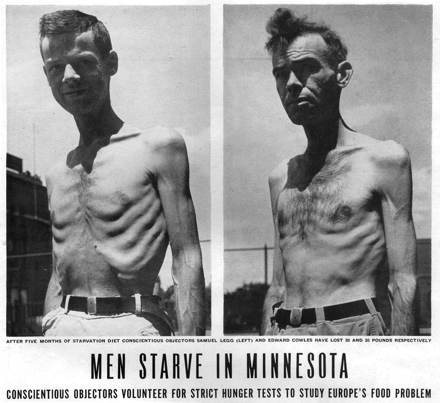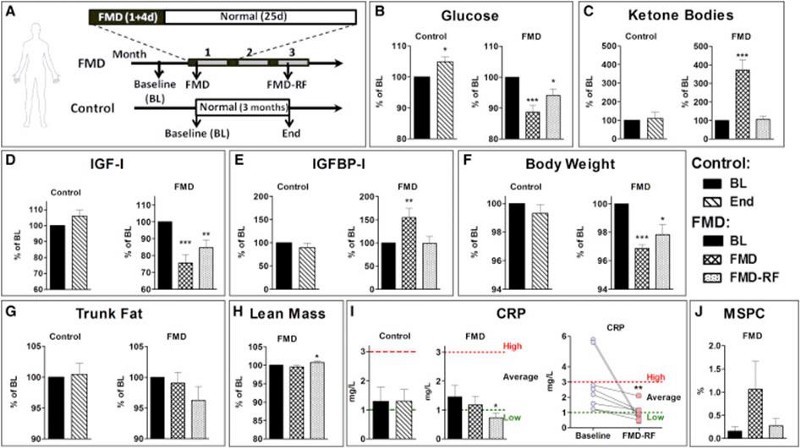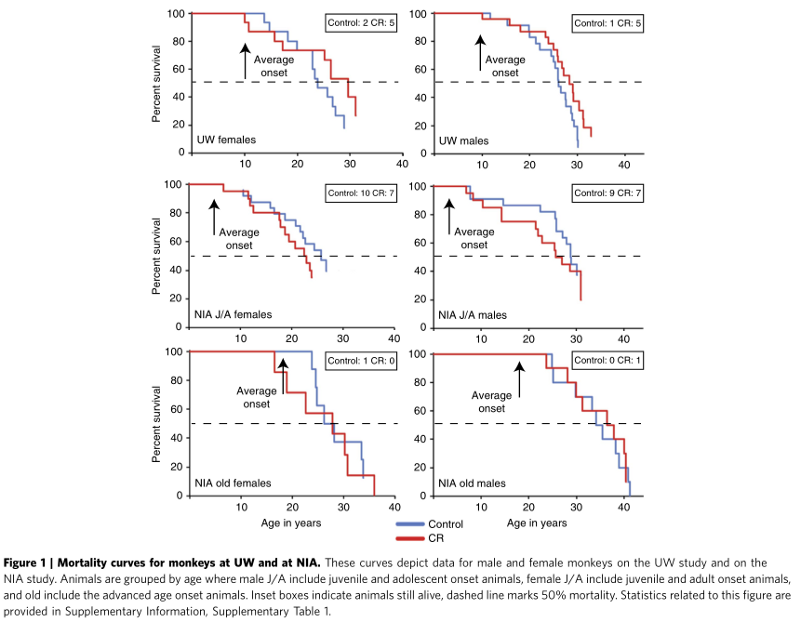Starve, do not starve - 2
Well, I’m really guilty of that: I consider calorie restriction a type of starvation, but in the original article I mention many times that it was exactly the 30% calorie restriction that was studied in the monkey experiments. However, the “present”, from the point of view of purists, starvation is also described there: this is a study of the effect on the prolongation of life from feeding every other day ( every other day feeding ) on rats, so there’s no bias on my part. can.
In my interpretation of the term “starvation,” I am far from alone. Dictionaries define it exactly the same:
Starvation:
the state of the body that develops with the complete absence or lack of food , its incomplete composition, as well as violations of digestion and assimilation of nutrients.
FAST - FAST, ay, ay; nesover 1. To experience hunger (in 2 and 3 numbers). Help the starving (n). 2. Refrain from eating or sharply limit yourself to food . G. in fasting days. | noun fasting, I, cf. Medical city
Dictionary Ozhegova
Starve - no. nepereh. 1. To experience hunger 2., 3. for a long time; eat poorly, eat less . 2. To abstain from food for any purpose.
Modern Dictionary of the Russian language Ephraim
Scientists also agree with this interpretation of the term: the famous study of malnutrition in humans, conducted in 1944 in the United States was called the “Minnesota study of starvation” ( Minnesota Starvation Experiment ). By the way, this was a very interesting experiment: 36 out-of-prisoners from conscription (selected from 400 initially willing to participate in the experiment) received 1800 kcal per day for six months (with a daily rate of an adult man of 2500-2600 kcal). That is, they were subjected to the same 30% calorie restriction as later macaques. As a result, many of them almost went crazy on food during this time:
Almost immediately, the subjects reported a decrease in both physical energy and motivation. Researchers have noted the strongest apathy among the subjects, alternating with paradoxical periods of irrational irritability. “The line for food has become a source of contention,” they write in Men and Hunger. At the table they often quarreled, they were annoyed by the voices of each other and the increasingly strange eating habits that they had developed.
“They could coddle [with food] as with a child, or shake it over gold. They played with her like children building kulichiki, ”one participant wrote. Over time, licking plates became common, as men were looking for ways to extend their meal times and / or feel more full. They diluted potatoes with water, kept bitten pieces of food in their mouths, without swallowing them for a long time, or tried to combine food on a plate, “making strange and seemingly tasteless combinations,” the researchers report.
Food has become the only source of passion and motivation. Many men began to obsessively collect recipes (“I didn’t sleep until 5 in the morning, studying cookbooks,” wrote one). Meanwhile, all the other elements of life seemed to disappear in a simple background noise. Again and again, researchers have reported indifference and boredom, their sexual desire has evaporated. At parties, the subjects found maintaining the conversation difficult and meaningless. They all preferred solo movie trips, adding that, although they could recognize the comedy, they no longer feel like laughing.
Finally, the fasting phase is over, and the 20-week rehabilitation period begins. It was at this stage that the most unexpected discovery was made: if the physical recovery even slowly but progressed, then the psychological state of the subjects deteriorated. Licking the plates continued, irritability turned into aggression, and mood swings became more serious. Once, chopping wood, Samuel Legge cut off three fingers for himself. “I admit that at that time I was not in my head,” Legg explained later. “I'm not ready to say that I did it on purpose. But I'm not ready to say the opposite. "
To everyone's relief, the mood of the subjects and social behavior stabilized three months later. But in relation to food, the men agreed that they did not "return to normal." Many ate “more or less continuously,” and the test group continued to overeat even eight months later.
Here are a couple of “undernourished” during the experiment:

It is worth mentioning that in 2003-2004, interviews were conducted with some of the participants in this study, and at that time half of them (19 out of 36) were still alive - at the age of over 80 years. Some believe that this fact is a reflection of the benefits of starvation, since the average life expectancy for men in the United States born in the 1920s was about 75 years in 2004. However, I do not think so.
Firstly, if 100% of the experiment participants had survived until 2004, then one would still be surprised. And the fact that half of that cohort has lived more than the average for the population still does not mean anything: due to child mortality (and, perhaps, those killed in WWII, I am not sure if they included in the calculation of mean RV) values (i.e., the age to which 50% of the cohort born in a certain period lives). Therefore, the median value of the pancreas for those born in the 1920s is about 80 years, I think it is. And the median value is therefore median, because half of the population lives longer than it.
And secondly, even if these 19 people live longer than average, one should not forget that they initially had improved health - otherwise they would not have passed the primary selection of 400 volunteers.
So what is trub starvation?
It's funny that those who fool me on my use of the term “starvation” define it for themselves as “that which reduces insulin-like growth factor (IGF-1 )”. For example, Fasting Mimicking Diet (FMD) is a diet simulating fasting. Given that this diet itself, by definition, is not starvation (the first day is 1100 kcal, 2–5 days 700 kcal). Yes, and with IHF-1 there is not everything going smoothly - after returning to a normal diet, IGF-1 for a few days, most likely, returns to its original value. I know at least one case where the IGF-1 value a few days after the completion of the FMD was higher than the original before the diet. I also know of another case in which IGF-1 fell by 35% on a five-day “anti-diet” lamb with wine. By the way, alcohol reduces IGF-1 :

So, maybe, the fans of his decline should think about how to replace a diet that simulates starvation to a diet that simulates hard drinking? Just kidding.
In any case, in the study referred to by the supporters of FMD, the IGF-1 value 5–8 days after returning to the normal diet was only 15% lower than the original value (see chart D):

True, for some reason, the IGF-1 values of the whole group are summed up there, and it is the group average that is compared. That is, the average temperature in the hospital: 100% taken the level of the whole group before the diet, and then the IGF-1 values are determined as a percentage of it after the 1st FMD cycle and after 5–8 days of the normal diet after (for some reason) 3 th cycle FMD. It seems to me that this is a very strange approach: after all, one outlayer can greatly influence all the statistics of a group. For example, if almost everyone had an average level of 100 units, and it dropped to 90 units, and someone had 200 and dropped to 90, and here we have the pattern of decline of the whole group is distorted, and the volatility is masked. It seems to me that it would be better to look at the individual reduction values of each participant.
It is also strange that the IGF-1 level immediately after fasting was taken after the first FMD cycle, and the IGF-1 level after 5–8 days of a normal diet was taken after the third cycle (that is, 75 days after the start of the study). But even so, the average value of IGF-1 5–8 days after the resumption of the diet, the variation (standard error) plus or minus 6–7%. Well, the fact that IGF-1, after 5–8 days of withdrawal from fasting, is 15% lower than the original value 3.5 months ago - that says little. I think that after a few more days of the usual diet, IGF-1 will return to its original level.
By the way, the extension of life in mice from FMD is also not so hot:

And how much these 11% of the median extension of the pancreas of mice can be transmitted in primates is another big question.
By the way, about 11% of the extension in primates. Someone saw a 11% median extension in females from the UW study on the first graph below, and accused me of inaccuracy when I said that “calorie restriction [in these studies] did not extend the life of primates by more than 5%”.

Personally, my tongue does not turn to call what we see in these females, “by 11% extension”. There are intertwined curves of survival of groups, and there is no monotony, based on which we could talk about some guaranteed (albeit small) effect. The effect is negative, then positive, then disappears again. In any case, that 3% of the extension of the pancreas in males, that 11% in females, or -5% in other groups, for me are absolutely scanty indicators for which you absolutely should not torture your body.
But at the same time I repeat - this does not mean that it is possible with impunity for one’s health to eat if not to oneself! Not at all - overeating is very fraught with a reduction in your pancreas, and certainly the deterioration of its quality. Especially the abuse of sugar (that is, in fact, any simple carbohydrates, which in a few minutes are broken down to glucose or fructose after it enters your body). And yet, yes, evil sugar increases the likelihood of you having diabetes and Alzheimer's - after all, it’s not for nothing that the latter is called “type 3 diabetes”:
"In patients with type 2 diabetes, a sharp decline in cognitive function is often observed, and almost 70% of them eventually develop Alzheimer's disease."
A source
Here is a good scientific article on this topic.
And the meat can be?
But the fact that meat is even more harmful than sugar, as some people wrote to me, is not at all a fact. A recent population-based study showed that meat eaters generally live a little longer than vegetarians, and only “fish vegetarians” (fish silently protest this term) live a little longer than meat eaters (that is, their risk of mortality in the Cox proportional hazards model below):
“All-cause mortality for vegetarians versus non-vegetarians [HR = 1.16 (95% CI 0.93–1.45)]. Mortality risk between pesco-vegetarians [HR = 0.79 (95% CI 0.59–1.06)] or semi-vegetarians [HR = 1.12 (95% CI 0.96–1.31)] versus regular meat eaters. We found no evidence that following a vegetarian diet, a semi-vegetarian diet or a pesco-vegetarian diet.
At the same time, the statistical significance of all of these conclusions is rather low, but it is quite enough to say that there is no significant difference between the life span of vegetarians and meat eaters.
In conclusion, I want to say that I am very grateful for all the criticism received. After all, she helps me to refine my understanding. So to all who wrote - many thanks!
UPD: I share my personal experiences of 5-day fasting here .
All Articles